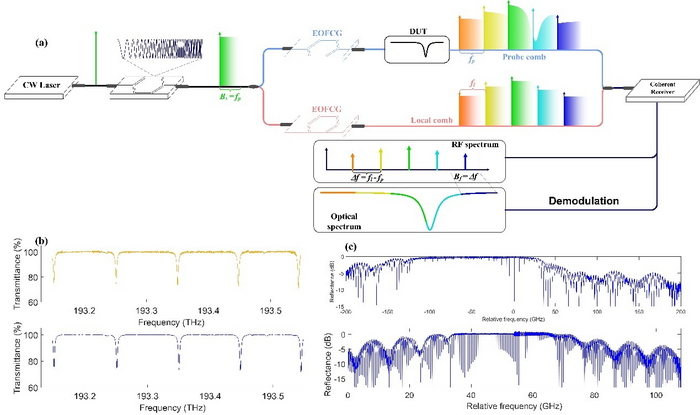The optical frequency comb (OFC), similar to a comb (or rule) in optical frequency, offers equidistant comb lines across a wide bandwidth. Each comb line corresponds to an absolute optical frequency.
 (a) The schematic of the proposed EO-DCS with sub-fm resolution and absolute frequency reference; (b) HCN absorption spectrum and (c) resonance spectrum of fiber F-P cavity measured by the proposed technique. Image Credit: OEA
(a) The schematic of the proposed EO-DCS with sub-fm resolution and absolute frequency reference; (b) HCN absorption spectrum and (c) resonance spectrum of fiber F-P cavity measured by the proposed technique. Image Credit: OEA
In 1999, research groups from the National Institute of Standard and Technology (NIST) and the Max-Planck Institute for Quantum Optics (MPQ) resolved the problem of absolute optical frequency measurement by realizing OFC. As a result, researchers J. H. Hall and T. W. Hänsch were given the 2005 Nobel Prize in Physics.
OFC also transformed the domain of spectroscopy, where the spectral resolution could reach the picometer level. This has also given rise to new methods and applications in the field of comb-based spectroscopy.
Among comb-based measurement techniques, dual-comb spectroscopy (DCS) stands out for its ability to fully leverage the good qualities of OFCs in terms of frequency accuracy, frequency resolution, spectrum range, and pulse width.
DCS, which is multi-heterodyne detection of two OFCs in the frequency domain and has a tiny repetition rate difference, can convert recorded spectrum, such as the molecular absorption spectra, from optical frequency to radio frequency.
By adopting the spectral interleaving approach, DCS’s spectral resolution might be increased to tens of femtometers. However, there are still a lot of drawbacks to these methods.
For instance, due to the lengthy measurement period, absolute frequency reference cannot be provided by temperature-based or driving current-based tuning procedures. Additionally, there is still room to raise the spectral resolution to comb line linewidth levels.
As they do not require expensive phase-locking circuits or phase corrections, electro-optic frequency combs (EOFCs) made by electro-optic modulation from a continuous-wave seed laser have intrinsic mutual coherence in DCS.
This greatly simplifies the complexity of the system. Furthermore, EOFCs have an adjustable center wavelength and a repetition rate that is not constrained by cavity length; as a result, DCS based on EOFCs has potential applications and is of interest to researchers.
A revolutionary DCS approach based on EOFCs is proposed by Prof. Xinyu Fan’s research team at Shanghai Jiao Tong University, which increases the spectral resolution by two orders of magnitude to sub-femtometer.
The stabilized seed laser is externally controlled to act as the seed light wave of the sweeping EOFC, allowing for quick spectrum interleaving with minimal frequency error as well as providing a precise frequency reference.
The study team enhances spectral resolution, bandwidth, and measurement duration to Nyquist-limitation by considering theoretical constraints and trade-offs of the essential parameter.
The molecular absorption spectrum and the high-Q fiber Fabry-Perot resonance spectrum measurements show how quickly the suggested approach can measure while having an extremely high spectral resolution and signal-to-noise ratio.
This scientific breakthrough might aid in the advancement of hyperfine comb-based spectroscopy and be used to monitor green gases, precisely test optical devices, detect biochemicals, and observe physical phenomena like electromagnetically induced transparency.
Journal Reference:
Xu, B., et al. (2022) Sub-femtometer-resolution absolute spectroscopy with sweeping electro-optic combs. Opto-Electronic Advances. doi:10.29026/oea.2022.210023.